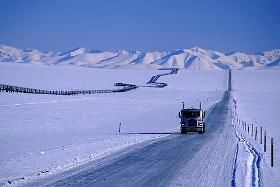Trip Plan My Load For Me!
Topic 5904 | Page 3

Trip plan #2 Via US26 and US191.
Daniel remains in sleeper berth until 0100 on 10/23, extending his sleeper time to 8 hours. This is midnight Pacific Time, his home timezone, so he's into another day. He's also extended his 14 hours because he's going to take advantage of sleeper birth provision. That or I will make him commit a terrible log book violation.
At 0100 MT on10/23 Daniel now has 6:27 drive time, 6:53 duty time (because of sleeper birth), 10:44 additional hours duty time in recap, 8 hours to 30 minute break.
Plan: 10/22 1900 - six (6) more hours of sleeper berth.
10/23 0100 South on I15 to US26 in Idaho Falls, then east on US26 to US191 south. Daniel should reach the junction of US191 and I80 after 5:50 driving (6:50). There is a Flying J there, and although he could drive a bit longer he stops there does his post trip and shuts down at 0700 for two hours.
10/23 0900 It's a new (driving) day. Daniel has 10:44 hours of duty time. 8 hours on his 30 break, and 349 more miles to go to Henderson CO. Pre trip and leave the FJ and onto I80 east. After 6 hours of driving Daniel arrives at the receiver at 1700 - 5 hours early.
I calculated the driving times as 55 m/hr on US routes and 60 m/hr on the interstate. There's a bit of slack in here, so if Daniel takes a bit longer in the mountains, he still can get to the Flying J in Rock Springs before his 6:27 of drive time is up. Of course, he could stay there longer than two hours, so as to not arrive quite so early.
Sleeper Berth:
The portion of the tractor behind the seats which acts as the "living space" for the driver. It generally contains a bed (or bunk beds), cabinets, lights, temperature control knobs, and 12 volt plugs for power.
Interstate:
Commercial trade, business, movement of goods or money, or transportation from one state to another, regulated by the Federal Department Of Transportation (DOT).
Before I begin, everyone who participated in this I want to tell you how great of a job you're doing for yourself. It doesn't matter if your answer was wrong or right, what matters is that you came out of your comfort zone and attempted to do this without having any training. You don't know the material and yet you still gave it a shot. That is exactly the type of personality that trucking demands. Listen, you're never going to be in your comfort zone especially as a rookie. Think about it, you think you'll be comfortable in the truck for the first time? Think you'll be comfortable when you get your first solo truck? Absolutely not! You will not know what you're doing, you'll be a little scared honestly, but that won't stop you - you'll still give it your best shot! You won't be in your comfort zone for at least the first 6 months in trucking and its a great thing how some of you already have the motivation to get out there and try to learn. I applaud you all! It takes a willingness to come out here and try a difficult question without even know your HOS yet. I offer my mentorship to all of you, if you want it that is.
As for the people who sheltered themselves from an activity that would do nothing but help you out, I wish you luck in trucking. The difference between bad trip planning and excellent trip planning is 15,000 net and 45,000 net. You could say "I didn't do it because I don't know how". That's fine, but is that what you're going to say when you're in the truck for the first time trying to put it in second gear? Just because you don't know how doesn't mean it won't be worth it to try. We all start from somewhere, and the first step is coming out of your comfort zone so you can open the opportunity to learn.
Anyways, out of everyone Michael S. was the closest to the answer. But no one got the actual answer. A Split Sleeper Birth was not necessary and this load will still be an easy delivery. But I applaud you all for the attempts, this was not easy.
Your route is as follows:
I-15 S to E County Line Rd. The whole point of this is so that you won't have to go all the way down to the junction of I15 and US20. A great shortcut, but as always with small roads - watch for weight restrictions.
Then you want to take US20 to ID-48 E. This is a shortcut to get on US-26 E.
This will take you directly to US-26 E.
Your next goal is to get to Rock Springs, WY via US-26 E to US-189 S to US-191 S.
Why did I choose the US highways? Yep, they have mountains, but so do the interstates. You're hardly sheltering yourself by taking the interstates, you're just adding more miles to the load.
At Rock Springs, WY you want to take I-80 E to I-25 S straight into Denver and ultimately into Henderson, CO.
Total Miles: 665.
Hours of Service:
8 hours of 8 hours. (30 minute break clock) This clock doesn't matter.
6 hours and 27 minutes of 11 hours (11 hour drive time) This clock does not matter because the 70 hour clock takes priority.
4 hours and 53 minutes of 14 hours (14 hour clock) This clock doesn't matter.
1 hour and 21 minutes of 70 hours (70 hour clock) This is the most important clock we have to manage right now!
Recap: 10 hours and 44 minutes. This will be our most important clock tomorrow!
It is currently 1900 Mountain Time, our delivery is also Mountain Time, so lets take note that there will be no time zone change.
It is 1900, I will drive right now and get to a small Conoco truck stop on US-26 just East of Idaho Falls, ID.
Tip: Get one of these! It tells you where all the truck stops and rest areas are at.
This will eat your clock for today because its about 70 miles away. You'll need to floor it and preserve every second of your clock that you can. You should be able to log a short post trip inspection by the end of the day. I know I was able to.
We have traveled 70 miles out of 665 which means we are now left with 595 miles and 10 hours and 44 minutes left to drive tomorrow.
It was 1900, but by the time we ended our shift it was 2021. Lets just say 2030 for simplicity. 10 hours later it will be 0630 and we will be ready to roll.
10 hours and 44 minutes is plenty of time to drive 595 miles! We also have from 0630 to 2200 to get there. Plenty of time! But I will hustle to avoid traffic near the Fort Collins/ Denver area. I will work from 0630 until 1230 and take a 30 minutes break.
That's 6 hours of work so now we're looking at 4 hours and 44 minutes. I will drive those remaining hours and arrive at Henderson, CO at approximately 1830. If we hit traffic I'll still make the delivery on time. At 62mph with a full clock you can legally do about 660 miles or so, using that logic we can easily do 595 miles in 10 hours and 44 minutes. Heavy or not, we have the hours.
We did not need to scale this load because a Lightweight Truck can easily haul this load with plenty of room. However, if I was driving anything I would be overweight without a doubt.
Any questions feel free to ask! Thanks!
Interstate:
Commercial trade, business, movement of goods or money, or transportation from one state to another, regulated by the Federal Department Of Transportation (DOT).
HOS:
Hours Of Service
HOS refers to the logbook hours of service regulations.OOS:
When a violation by either a driver or company is confirmed, an out-of-service order removes either the driver or the vehicle from the roadway until the violation is corrected.

So did you scale out at the shipper , or the truck stop on US-26? And is there a reason for that choice?
Yeah, Ideally, I'd have the 2014 truck stop directory and the trucking atlas we used in school, but right now all I have is an Android with Google Maps!
Shipper:
The customer who is shipping the freight. This is where the driver will pick up a load and then deliver it to the receiver or consignee.
So did you scale out at the shipper , or the truck stop on US-26? And is there a reason for that choice?
Yeah, Ideally, I'd have the 2014 truck stop directory and the trucking atlas we used in school, but right now all I have is an Android with Google Maps!
I scaled out at the shipper using only my gross weight.
It showed me at 78,000 gross. So that means if I'm 12000 on steers, 33,000 on drives, and 33,000 on trailer I'll be legal. I slid my tandems forward until my Right Weigh Gauge showed 33,500lb on my drives.
Right Weigh Gauge is a gauge on the dashboard that shows you how much weight is on your drive axles. It is possible to balance yourself using it alone.
I knew I was legal so I went with it.
Shipper:
The customer who is shipping the freight. This is where the driver will pick up a load and then deliver it to the receiver or consignee.
Tandems:
Tandem Axles
A set of axles spaced close together, legally defined as more than 40 and less than 96 inches apart by the USDOT. Drivers tend to refer to the tandem axles on their trailer as just "tandems". You might hear a driver say, "I'm 400 pounds overweight on my tandems", referring to his trailer tandems, not his tractor tandems. Tractor tandems are generally just referred to as "drives" which is short for "drive axles".
Tandem:
Tandem Axles
A set of axles spaced close together, legally defined as more than 40 and less than 96 inches apart by the USDOT. Drivers tend to refer to the tandem axles on their trailer as just "tandems". You might hear a driver say, "I'm 400 pounds overweight on my tandems", referring to his trailer tandems, not his tractor tandems. Tractor tandems are generally just referred to as "drives" which is short for "drive axles".

One thing that I would like to mention that seems to be forgotten since you are working off of recap is that you can do your post trip after the 70 hour limit is reached. The point being that you can work after the 70 hours are reached but you CANNOT drive when you reach that limit. This helps to know if you need all your hours to get to your destination. It will cause you to start a little later the next day.

Thanks for the answer and encouraging words. I know I still have a ton to learn about this business.
New Reply:
New! Check out our help videos for a better understanding of our forum features

















Preview:
This topic has the following tags:
Advice For New Truck Drivers Hours Of Service Life On The Road Trip Planning







 TT On Facebook
TT On Facebook
Feel free to give it a second attempt!